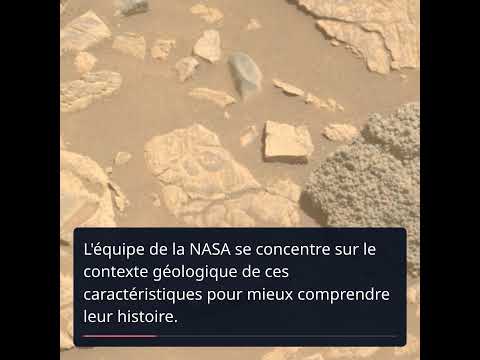| IN BRIEF |
|
The planet Mars continuously fascinates scientists and the public with its captivating discoveries. The latest finding by NASA’s Perseverance rover is a unique rock adorned with small spheres that intrigue experts. This discovery raises questions about the geological and possibly biological history of the red planet. Ongoing analyses could shed light on Mars’s past conditions and enhance our understanding of its complex surface.
The Fascinating Discovery of “Saint-Paul Bay”
The Perseverance rover, currently on a mission to Mars, has recently uncovered a rock at Broom Point, located on the edge of Jezero Crater. This rock formation, named “Saint-Paul Bay,” stands out due to its unprecedented texture: it is covered in small dark gray spheres, each about one millimeter in size. These spheres exhibit a wide range of shapes, with some being elliptical, others broken, or perforated with tiny holes. This structure piques the interest of scientists as it may hold clues about the history of water on Mars.
A previous discovery by Perseverance had revealed a rock with patterns referred to as “leopard spots.” These patterns had already raised questions about possible past biological activity. The similarity to the newly found spheres supports the hypothesis of complex interactions between water and Martian rocks.
Hypotheses About the Origin of the Spheres
The Martian spheres give rise to various hypotheses concerning their origin. One dominant theory suggests they are the result of concretions formed by underground water. However, other theories are explored. On Earth, similar formations can arise from volcanic eruptions or meteorite impacts when materials vaporized condense.
The NASA team strives to place this discovery within its geological context. By examining the surrounding layers, researchers aim to determine the origin of these spheres. Such analysis could reveal valuable information about the history of Jezero Crater and provide insights into the conditions that once existed on Mars.
Implications for the Study of Mars
Understanding the formation of the spheres discovered by Perseverance has significant implications for the study of Mars. These analyses could offer clues regarding the past presence of liquid water, an essential element for considering the possibility of life. Similar formations observed on Earth are often associated with humid environments, suggesting that Mars may have experienced periods of milder and wetter climate.
The ongoing research fits into a broader framework aimed at reconstructing Mars’s climatic history. Each new discovery, such as that of “Saint-Paul Bay,” enriches our understanding of the geological and potentially biological processes that have shaped the planet.
The Future of Martian Exploration
The discoveries made by Perseverance are just one step in the exploration of Mars. NASA plans further missions to deepen the study of the red planet. These future missions may include sample return to Earth for more detailed analysis. Such an approach would confirm current hypotheses and open new avenues for understanding Mars’s past habitability.
International collaborations also play a crucial role in these explorations. By sharing data and technologies, space agencies worldwide contribute to a comprehensive understanding of Mars. This international cooperation is essential to overcome the technical and scientific challenges of space exploration.
As research continues, each discovery like that of the Perseverance rover enhances our understanding of Mars. What will be the next significant finding that could reshape our perception of the red planet and its complex history?








